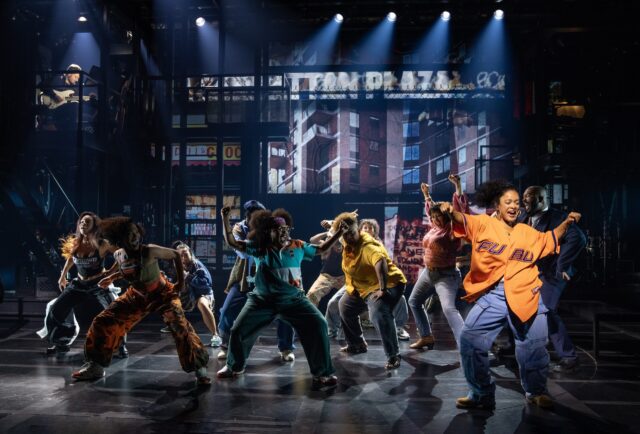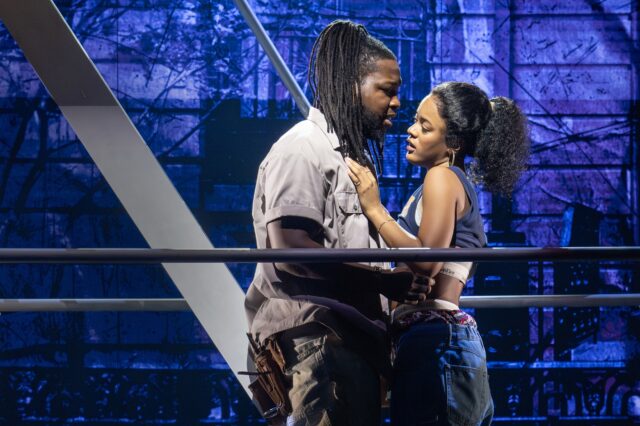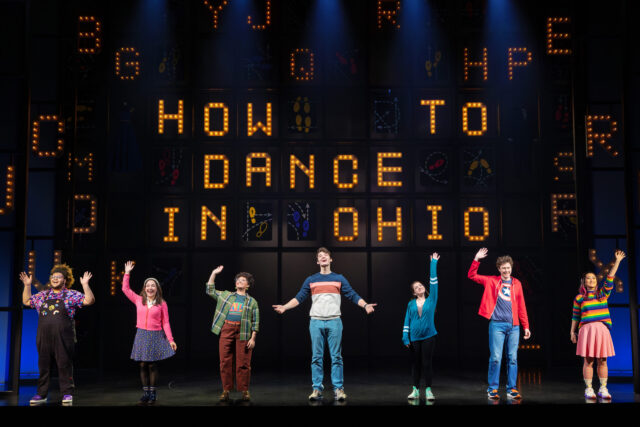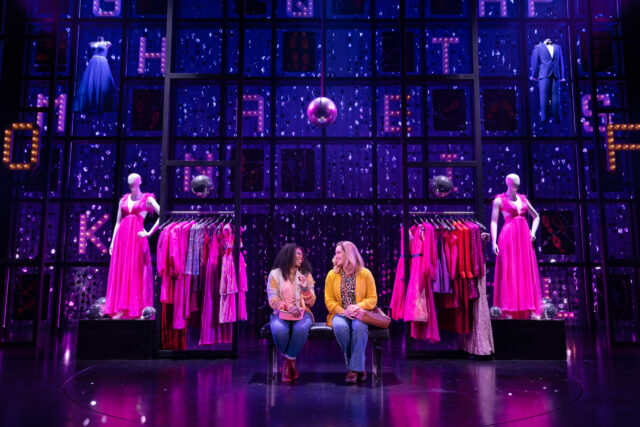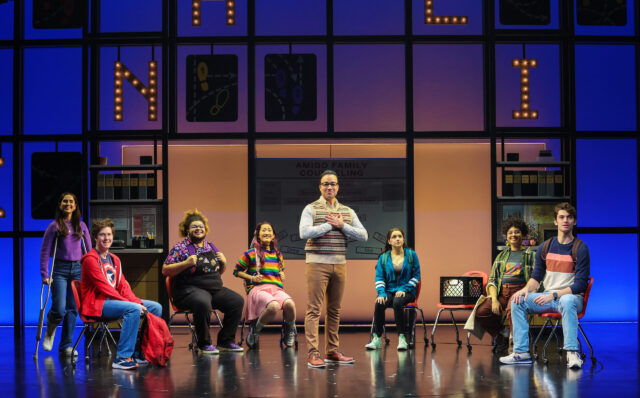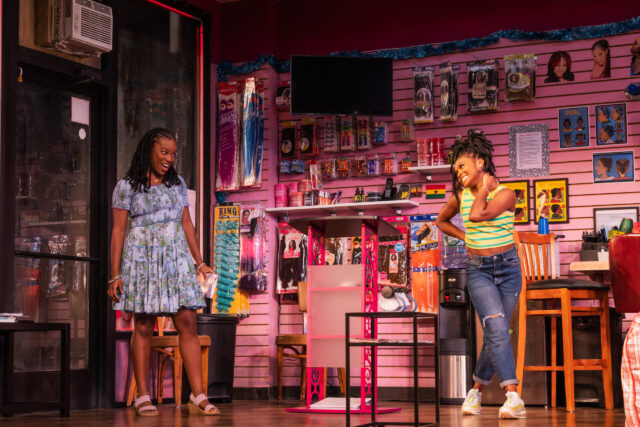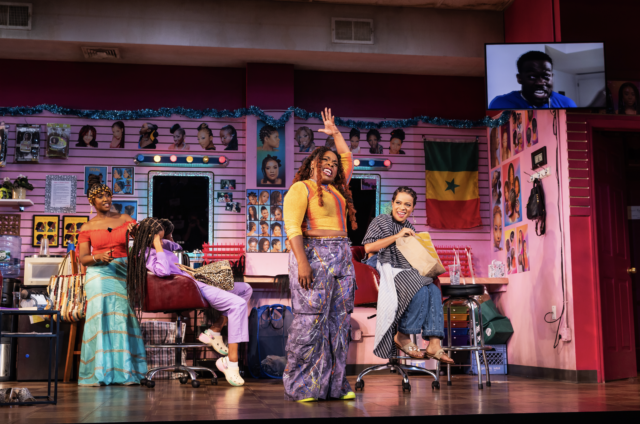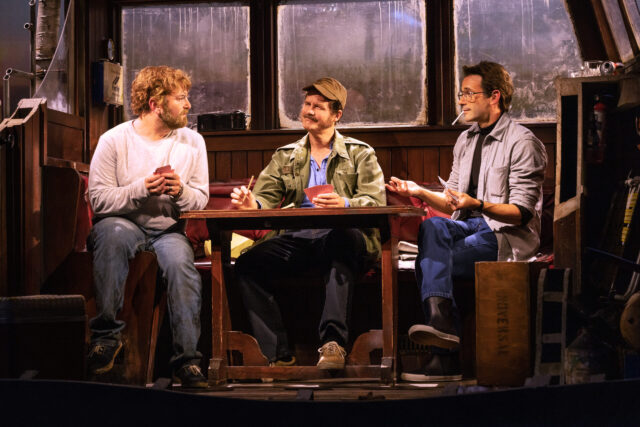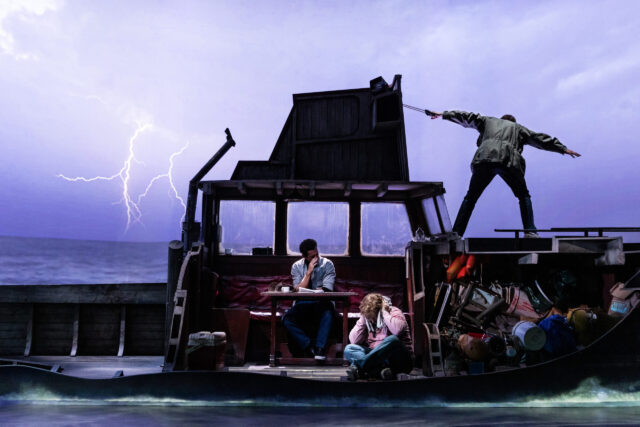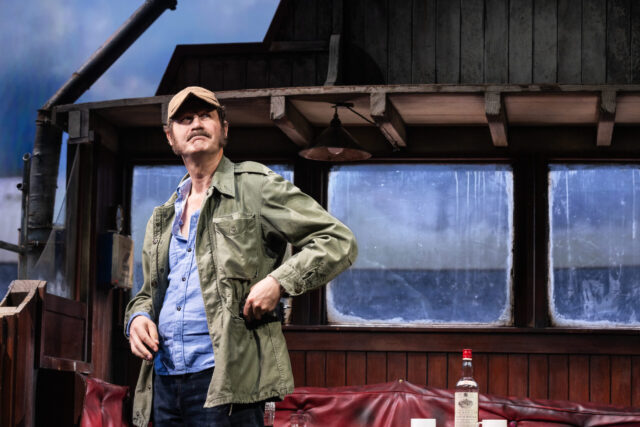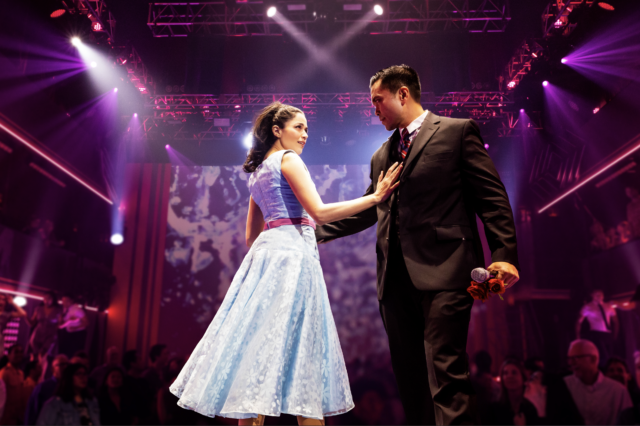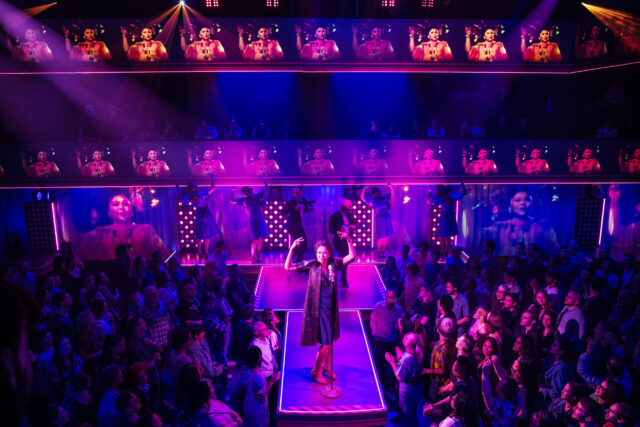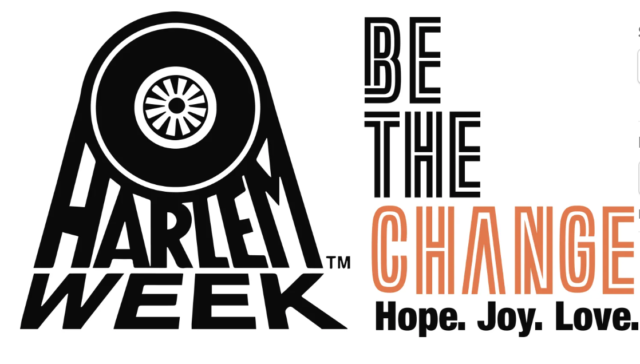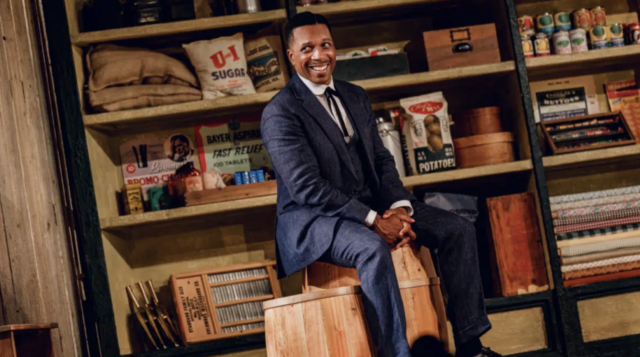
Leslie Odom Jr. stars as the title character in the prescient and uproarious Purlie Victorious: A Non-Confederate Romp Through the Cotton Patch (photo by Marc J. Franklin)
PURLIE VICTORIOUS: A NON-CONFEDERATE ROMP THROUGH THE COTTON PATCH
Music Box Theatre
239 West 45th St. between Broadway & Eighth Aves.
Wednesday – Sunday through February 4, $58 – $298
purlievictorious.com
Kenny Leon’s revival of Ossie Davis’s Purlie Victorious: A Non-Confederate Romp Through the Cotton Patch was already a special experience; they’re now upping the ante with a series of talkbacks as the show heads into its final weeks at the Music Box Theatre.
The original premiered on Broadway in 1961, with a cast that included Davis as fast-talking preacher-dreamer Purlie Victorious Judson, Ruby Dee as Lutiebell Gussie Mae Jenkins, Sorrell Booke as cotton plantation owner Ol’ Cap’n (Stonewall Jackson) Cotchipee, Alan Alda as his ne’-er-do-well son, Charley, Tony-nominated Godfrey Cambridge as obedient servant Gitlow Judson, Helen Martin as his wife, Aunt Missy, who runs the house, and Beah Richards as Idella Landy, who watches out for Charley.
Leon has assembled another ace cast for his sparkling adaptation, a prescient play so funny and on point that you’ll be wondering why you haven’t heard about it before — although some will recall the 1970 musical version, Purlie, which featured Cleavon Little as Purlie and Melba Moore as Lutiebell. Leslie Odom Jr. is phenomenal as the title character, who wants to pretend that Lutiebell (a scene-stealing Kara Young) is his cousin Bee so she can collect her late mother’s $500 inheritance from Ol’ Cap’n (Jay O. Sanders) and Purlie can reclaim Big Bethel as his church. Missy (Heather Alicia Simms) is highly suspicious of the plan, while Gitlow (Billy Eugene Jones) doesn’t want to get involved in anything that might upset Ol’ Cap’n. When Charley (Noah Robbins) goes missing, Idella (Vanessa Bell Calloway) is beside herself, but Purlie isn’t about to let anything get in the way of his acquisition of Big Bethel. Meanwhile, Derek McLane’s evolving sets are so fabulous that the last one draws gasps of approval and applause from the audience.
“There’s a whole lotta things about the Negro question you ain’t thought of!” Purlie proclaims to Lutiebell. “The South is split like a fat man’s underwear; and somebody beside the Supreme Court has got to make a stand for the everlasting glory of our people!”
Purlie Victorious must close on February 4; they’ve added a series of “Victorious Talkbacks” that began January 11 with Adrienne Warren and continues January 18 with Moore and January 25 with Lin-Manuel Miranda.
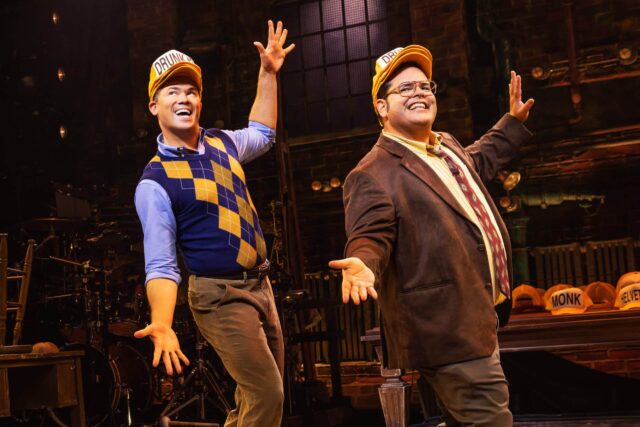
Andrew Rannells and Josh Gad team up again in Gutenberg! The Musical! (photo by Matthew Murphy)
GUTENBERG! THE MUSICAL!
James Earl Jones Theatre
138 West Forty-Eighth St. between Sixth & Seventh Aves.
Tuesday – Sunday through January 28, $74-$498
gutenbergbway.com
Lightning doesn’t strike twice for Josh Gad and Andrew Rannells, who first teamed up for the nonstop juggernaut The Book of Mormon in 2011, both earning Tony nominations. The dynamic duo is back in the double-exclamation-pointed Gutenberg! The Musical!, which are two bangs too many. It’s scheduled to close January 28.
Written by Scott Brown and Anthony King, the two-act version premiered off Broadway in 2006 with three-time Tony nominee Christopher Fitzgerald and Obie winner and Tony nominee Jeremy Shamos. In this new iteration of the meta-musical, Bud Davenport (Gad) and Doug Simon (Rannells), both from Nutley, New Jersey, have rented the James Earl Jones Theatre for one night to present their show, a musical about fifteenth-century German printer Johann Gutenberg, to a group of producers. They play all the characters, identifying them by putting on different hats, which say “Drunk #1,” “Helvetica,” “Bootblack,” “Trimmer,” and “Gutenberg,” among others.
Directed by Tony winner Alex Timbers, it starts out very funny, particularly as they discuss how they are including a serious issue in order to make sure the show is important — antisemitism — but as the story continues, it gets repetitive, going around in circles (literally and figuratively) as Bud and Doug keep interrupting the musical-within-a-musical to explain what they are doing, and why. The 2006 production was one act and forty-five minutes, and that feels about right; at two acts and two hours, it drags like a Saturday Night Live sketch that doesn’t know when to end.
The night I went, the best moment came when a woman from the audience shouted out to Bud, “You’re hot,” which Gad and Rannells ran with, cracking up themselves and the crowd with some fun improvisation.
There are plenty of good scripted lines — “In an actual production this song would include a gospel choir and lasers,” Doug notes; “I wish I was gay! But I’m just . . . not,” Bud opines — but the laughs dry up like, well, an underused, out-of-date printing press.
SPAMALOT
St. James Theatre
246 West Forty-Fourth St. between Broadway & Eighth Aves.
Tuesday – Sunday through July 28, $49-$225
spamalotthemusical.com
Monty Python’s Spamalot is back on Broadway and as hilarious as ever in this updated version gleefully directed and choreographed by Josh Rhodes.
With a book and lyrics by Python Eric Idle and music by John Du Prez and Idle, the endlessly punny show debuted on Broadway in 2005, with Tim Curry as King Arthur, Sara Ramirez as the Lady of the Lake, Hank Azaria as Sir Lancelot, David Hyde Pierce as Sir Robin, Michael McGrath as Patsy, Christopher Sieber as Sir Galahad, and Christian Borle as Prince Herbert, garnering fourteen Tony nominations and winning for Best Musical, Best Director (Mike Nichols), and Best Featured Actress (Ramirez). Based on the 1975 comedy Monty Python and the Holy Grail, one of the funniest movies ever made, Spamalot still holds up, skewering everything in its path.
This time around Tony winner James Monroe Iglehart is King Arthur, three-time Tony nominee Christopher Fitzgerald is Patsy, Leslie Rodriguez Kritzer is the Lady of the Lake, Tony nominee Ethan Slater is the Historian and Prince Herbert, two-time Tony nominee Alex Brightman has replaced the scene-stealing Taran Killam as Sir Lancelot, and Michael Urie is Sir Robin through January 21, after which he will be replaced by Jonathan Bennett.
While Sir Lancelot doesn’t get to save Sir Galahad from almost certain temptation and no one is asked to answer these questions three to cross the Bridge of Death, you will find just about everything else here, from a killer rabbit, the French taunter, and the Knights Who Say Ni to Dennis’s treatise on the exploitation of the workers, the Plague Village, and Sir Robin’s not-quite-bravery.
There are also tons of self-referential jokes: “We won’t succeed on Broadway / if we don’t have any Jews,” Sir Robin sings. “One in ev’ry show / there comes a song like this / It starts off soft and low / and ends up with a kiss,” the Lady of the Lake explains. “How are we going to put on a Broadway show? Broadway’s a thousand years in the future in a country that hasn’t yet been discovered,” Arthur worries. Also on the menu are “Find Your Grail,” “Whatever Happened to My Part?,” and “Always Look on the Bright Side of Life.”
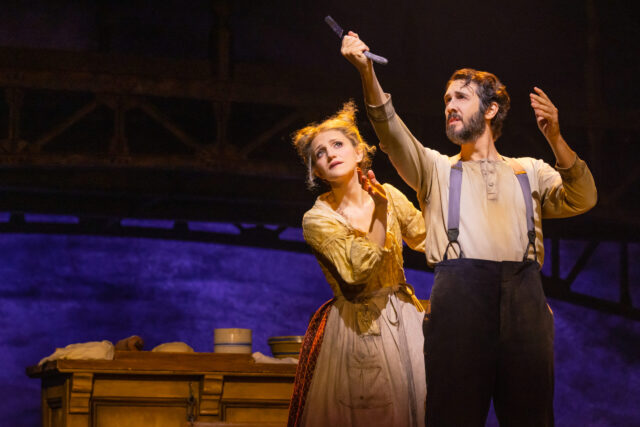
Annaleigh Ashford and Josh Groban go into devilish business together in Sweeney Todd (photo by Matthew Murphy and Evan Zimmerman)
SWEENEY TODD: THE DEMON BARBER OF FLEET STREET
Lunt-Fontanne Theatre
205 West Forty-Sixth St. between Broadway & Eighth Ave.
Wednesday – Sunday through May 5, $89-$435
sweeneytoddbroadway.com
Thomas Kail’s revival of Sweeney Todd: The Demon Barber of Fleet Street is devilishly delicious. The dark tale of a mysterious master barber who teams up with a macabre pie maker features memorable music and lyrics by Stephen Sondheim and a delightful book by Hugh Wheeler, based on a 1970 play by Christopher Bond.
The 1979 original Broadway production starred Len Cariou as the title character and Angela Lansbury as Mrs. Lovett and won eight Tonys, including Best Musical, Best Score, Best Leading Actor, and Best Leading Actress. The current third Broadway revival opened last March with Josh Groban as Sweeney Todd and Annaleigh Ashford as Mrs. Lovett, earning eight Tony nods and winning for Best Lighting and Best Sound.
On February 9, Tony winner Aaron Tveit picks up the shaving blade as Sweeney, with two-time Tony winner Sutton Foster taking over baking the pies; an unrecognizable Ruthie Ann Miles continues her Tony-nominated performance as the beggar woman.
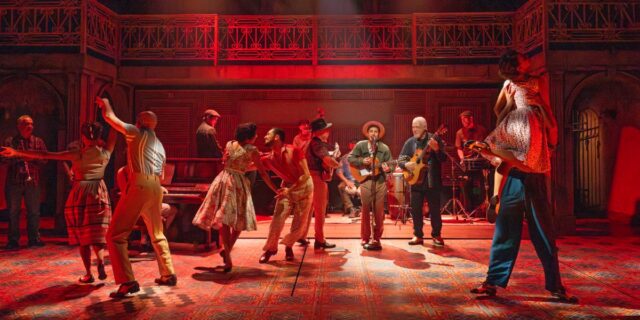
The exhilarating Buena Vista Social Club continues at the Atlantic through January 28 (photo by Ahron R. Foster)
BUENA VISTA SOCIAL CLUB
Atlantic Theater Company
Linda Gross Theater
336 West 20th St. between Eighth & Ninth Aves.
Tuesday – Sunday through January 28
atlantictheater.org
It would not be surprising if the Atlantic Theater’s world premiere of Buena Vista Social Club soon finds itself on Broadway; in the meantime, the sold-out run continues at the Linda Gross through January 28.
The two-hour musical was inspired by Wim Wenders’s 1999 Oscar-nominated documentary about Ry Cooder and his son, Joachim, traveling to Cuba to record an album with an ensemble known as the Buena Vista Social Club. Book writer Marco Ramirez has created a narrative, based on actual events, that goes back and forth between the 1950s, as the Cuban Revolution is simmering, and the economically depressed Special Period of the mid-1990s. Juan De Marcos (Luis Vega), who serves as narrator, explains early on, “Some of what follows is true / Some of it only feels true.” The real Juan De Marcos is a consultant on the show.
In 1996, Juan is trying to convince legendary singer Omara Portuondo (a sensational Natalie Venetia Belcon, in a gorgeous costume by Dede Ayite) to record an album in a Cuban studio with a band he has put together, including singer Eliades Ochoa (Renesito Avich). The possibility of singing some of her old songs takes her back to her youth, when she (Kenya Browne) and her sister, Haydee (Danaya Esperanza), were singing to tourists at the Tropicana until Haydee is enticed by guitarist Compay Segundo (Jared Machado) and pianist Rubén Gonzalez (Leonardo Reyna as a young man, Jainardo Batista Sterling as the older Rubén) to join them instead at the Buena Vista Social Club, a seedy nightspot in a dangerous part of town run by vocalist Ibrahim Ferrer (Olly Sholotan, although I saw understudy Justin Showell). Decades later, Compay (Julio Monge) seeks out Ibrahim (Mel Semé) to join in the recording, but he has no desire to revisit the past.
Although it does get sidetracked by bits of treacly melodrama, Buena Vista Social Club is splendidly directed by Tony nominee Saheem Ali, with energetic choreography by Patricia Delgado and Justin Peck on Arnulfo Maldonado’s inviting two-level set. The band is fantastic, performing such songs as “Silencio,” “Dos Gardenias,” “Veinte Años,” “El Carretero,” and “Y Tu Que Has Hecho?” Each member is worthy of mention: David Oquendo, Avich, and Monge on guitars, Javier Díaz, Mauricio Herrera, and Román Díaz on percussion, Guido Gonzalez on trumpet and flugelhorn, Hery Paz on woodwinds, Gustavo Schartz on bass, and Eddie Venegas on trombone. The performance of “Candela” alone is worth the price of admission, one of the best musical scenes of the year.
[Mark Rifkin is a Brooklyn-born, Manhattan-based writer and editor; you can follow him on Substack here.]
